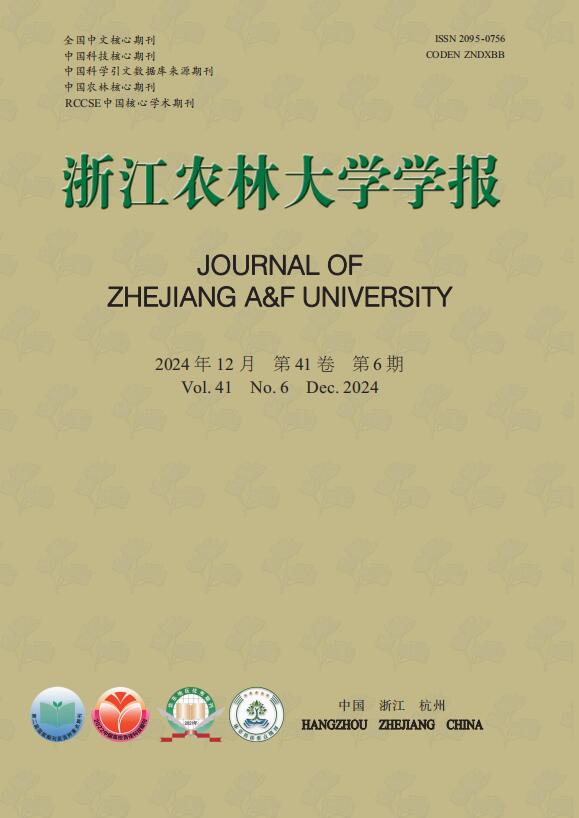-
建立健全生态产品价值实现机制,是深入贯彻践行“绿水青山就是金山银山”理念的重要举措。非木质林产品(non-timber forest product)是指在以森林为核心的生物群落中所能获取的除木材之外的其余各种可以满足人类生存或生产需要的产品与服务,主要包括木本油料、水果、森林药材、竹制品、食用菌、香料、野味等物质类产品以及森林旅游等服务类产品[1]。非木质林产品作为典型的物质供给类生态产品,兼具生态效益与经济效益[2],在促进山区农民增收与林业可持续发展中发挥着重要作用[3−5]。随着集体林权制度改革的深入推进,分山到户使得现有山区农户的非木质林产品以家庭经营为主,存在“多、小、散”等特点[6−7]。由于市场信息存在不对称性,导致小农户难以与市场形成高效对接,普遍存在优质不优价的问题。换言之,山区良好生态资源培育的非木质林产品所带来的品质优势并未体现在价格和销量上,“生态红利”未能得到充分释放。研究表明:组织嵌入显著提高了农户收入。这种促进作用不仅有利于破解农产品“柠檬市场”问题,还可以通过采取集体议价和订单农业等方式降低市场风险[8−9],提升生态产品溢价能力[10]。此外,区域公用品牌也是实现农业绿色生产、提高农户收入及推动乡村振兴的有效手段[11−13]。截至2020年底,浙江省丽水市生态产品价值实现试点的典型模式——“丽水山耕”等系列品牌,累计销售产品超108亿元,平均品牌溢价率超30%。然而,区域公用品牌商标的申请主体多为企业和合作社,农户准入机制尚未明确建立。因此,亟须从组织嵌入视角出发,探索农户参与区域公用品牌,并享受生态产品价值转化红利的有效路径。此外,不同产业组织类型及其利益联结模式对生态产品价值实现的提升效果也存在差异,有必要构建理论分析框架,以更好地诠释产业组织模式对非木质林产品价值实现的异质性影响及区域公用品牌在其中的作用机制。
学者们关于产业组织模式绩效的研究重点聚焦在其对生态化经营[14]、投入产出效率[15]、农产品质量安全[16−17]和绿色生产行为[18−19]等的影响。关于非木质林产品的价值实现,已有研究从问题瓶颈[20]、影响因素[21]和路径机制[22]等方面展开探讨。也有部分学者实证研究了区域公用品牌对农户绿色生产行为[23]以及农民收入增长[24]的影响。综上所述,现有研究均较少从微观视角关注农户参与不同产业组织模式对非木质林产品价值实现的影响差异,对区域公用品牌在其中的作用机制研究也较为缺乏。
相较于以往研究,本研究的边际贡献在于:其一,基于微观大样本实证检验不同产业组织模式对非木质林产品价值实现的影响。其二,分析区域公用品牌在产业组织模式对非木质林产品价值实现影响中的作用机制。其三,从经营规模和销售渠道的视角探讨产业组织模式对不同农户的异质性影响,以期为促进农户非木质林产品价值溢价增值提供科学决策和政策建议。
-
根据产业组织理论,按照利益联结主体和紧密程度不同,将产业组织模式归纳为3类:①“市场+农户”的市场交易模式。农户与买家之间不存在合作和契约关系,进行纯粹交易,农户独立生产和销售非木质林产品,随行就市。②“合作社+农户”的横向合作模式。农户作为合作社的成员,享有合作社所提供的生产技术、信息传递等相关服务,部分合作社还会负责产品的集中销售。③“公司+农户”的纵向协作模式。农户与下游公司建立契约关系,公司为农户提供必要的生产资料、技术支持和市场信息等,农户按照契约生产,并将其非木质林产品销售给公司。相比于市场交易模式,横向合作模式和纵向协作模式均能显著提高农户市场地位与产品议价能力[25],但两者因利益联结方式和运作机制存在异质性,导致农户在非木质林产品价值实现过程中的利益存在一定差异。具体而言,在横向合作模式中,合作社除追求经济效益外,还着重关注农村可持续发展,提升社会效益[26],并通过提供交易平台,共享资源、知识和技术,提高农户议价能力,以此为农户争取更高的产品市场价格[27]。尽管合作社在短期内可能面临管理和资金挑战,但它强调长期合作和共同利益使其在发展过程中更加稳定。相比之下,在纵向协作模式中,公司作为 “弱关系”嵌入农户网络之中,公司与农户之间完全以“工具型”关系为纽带,双方之间的联合完全出于利益诉求。这使得组织运行效率完全取决于组织内的激励和监督制度,从而使得合作双方容易因为利益诉求的差异产生摩擦。与公司相比,农户与合作社之间的关系更为直接且更加紧密,因而农户受合作社的影响更大。基于此,本研究提出第1个研究假说H1:相比市场交易模式,横向合作模式和纵向协作模式均对非木质林产品价值实现有促进作用,且横向合作模式的作用效果更显著。
根据原产地效应理论,产品来源地对消费者知觉和购买决策具有较强推动作用。区域公用品牌能够强化特定地区的生态特征、历史传统和生产技术[28],并通过此与非木质林产品价值产生关联。不仅如此,品牌也赋予了产品附加的心理价值[29]。区域公用品牌作为一种与特定地理区域紧密相关的品牌形式,有助于加强消费者与产品之间的情感联系,从而促使消费者愿意支付产品溢价[30]。由此可见,区域公用品牌能够借助地区声誉向市场发送非木质林产品的质量信号,将生态资源优势转化为商品优势和品牌价值收益,实现生态溢价,释放生态红利。区域公用品牌虽然能够带来一定程度的溢价,但准入门槛却存在异质性。分散经营的农户往往因其资源禀赋限制而被排斥在外,难以获得区域公用品牌为非木质林产品带来的溢价效应。产业组织则能够帮助农户通过组织化,克服资源禀赋的束缚,以“合作社+农户”或者“公司+农户”等利益联结方式使用区域公用品牌转化生态产品价值的红利。基于此,提出第2个研究假说H2:农户使用区域公用品牌在产业组织模式对非木质林产品价值实现过程中发挥了中介作用。
-
为实现研究目标,按照典型抽样和随机抽样相结合的原则,于2023年7—8月在浙江省选取非木质林产品较为丰富的7个县(市)开展实地调查。首先,根据当地政府部门和乡(镇)代表对当地乡(镇)的介绍以及人均地区生产总值数据,采用分层抽样的方法,选取经济发展水平较高和较低各2个乡(镇)。其次,每个乡(镇)按照村农民人均可支配收入进行分层,随机抽取经济发展较好和较差各1个行政村。最后每个村根据等距抽样选取20户农户作为样本户进行问卷调查。问卷内容涉及农户个人及家庭基本信息、非木质林产品经营、产业组织加入与区域公用品牌使用及农户认知情况等。调查均以调查员与农户一对一访谈形式完成。调查样本为7个县(市)28个乡(镇)56个村820户农户。有效问卷为811份,有效问卷率为98.9%。
-
研究表明:物质供给类生态产品价值主要通过市场交易方式实现[31],其价值实现体现为产品中蕴含的绿水青山的生态价值和人工投入的劳动价值,通过市场机制运作获得溢价。因此本研究用销售价格与市场平均价格的差占市场平均价格的比例计算非木质林产品溢价率,以此衡量农户非木质林产品价值实现程度。销售价格为农户当年销售的非木质林产品平均价格,市场平均价格则采用当地专业大户了解的非木质林产品当年市场平均价格。使用该数据的合理性在于部分大户本身就从事产品收购和加工业务,对生态产品外部市场的价格信息较为清楚。
-
本研究将“市场+农户”定义为市场交易模式,“合作社+农户”定义为横向合作模式,“公司+农户”定义为纵向协作模式。以市场交易模式为基准组,对参与多种产业组织模式的农户,选择非木质林产品销量最多的产业组织模式作为主要产业组织模式。
-
本研究选取的中介变量为是否使用区域公用品牌,“是”赋值为1,“否”赋值为0。其中,本研究数据所使用的区域公用品牌包括村级、县(市)级、省级和国家级4个层级,涵盖全品类和单一品类。
-
参考已有研究成果,选取以下变量:①个人和家庭特征(年龄、受教育程度、家庭村干部人数、家庭林业劳动时间、家庭劳动力数量)。②非木质林产品经营特征(经营规模、销售渠道、培训方式、种植阶段、种植年限、种植品种)。③区域虚拟变量。由于不同地区在社会经济发展、自然条件、林业生产经营相关政策存在差异,从而导致不同地区非木质林产品发展水平也存在差异,因此设置县级虚拟变量。关于县级虚拟变量,本研究以开化县作为参照,设置其他6个县级地区变量。
-
本研究关注的核心问题是产业组织模式对非木质林产品价值实现的影响,构建最小二乘法(OLS)进行回归估计。模型设定如下:
式(1)中:i表示农户,被解释变量Pi表示第i个农户的非木质林产品溢价率;核心解释变量Ii表示第i个农户参与的产业组织模式,是市场交易模式、横向交易模式和纵向交易模式3类变量的虚拟变量;解释变量Ci则为影响农户i的非木质林产品溢价率的控制变量,主要包括农户个人特征、家庭特征、经营特征、区域虚拟变量;$ {\alpha }_{0} $为常数项,$ {\alpha }_{1} $和$ {\alpha }_{2} $表示待估计解释变量的回归系数;εi为模型的扰动项。
-
根据前文研究假说,借鉴石大千等[32]的方法从区域公用品牌视角验证产业组织模式对非木质林产品价值实现的作用机制。具体实证检验采用3步法验证[33]:①将产业组织模式与非木质林产品价值实现进行回归,若系数显著,则表明产业组织嵌入对非木质林产品价值实现有正向促进作用。②将产业组织嵌入与加入区域公用品牌进行回归,若系数显著,说明产业组织嵌入有助于农户加入区域公用品牌。③将产业组织嵌入和区域公用品牌同时放入模型与非木质林产品溢价率进行回归,若系数不显著或者显著但系数降低了,则证明产业组织嵌入通过影响农户加入区域公用品牌促进非木质林产品溢价率提升。按照上述检验步骤,本研究机制验证模型设定如下:
式(2)~(4)中:Mi为中介变量,表示第i个农户经营的非木质林产品的区域公用品牌加入率;θ0、θ1、θ2为常数项;γ0、γ1、γ2、$ a、b、c、c'\mathrm{为}\mathrm{待}\mathrm{估}\mathrm{系}\mathrm{参}\mathrm{数};\mu\mathrm{\mathit{_i}表}\mathrm{示}\mathrm{随}\mathrm{机}\mathrm{扰}\mathrm{动}\mathrm{项} $;其余变量含义与前文基准模型(1)相同。
-
本研究所涉及的变量如表1所示。根据描述统计结果,2022年农户平均非木质林产品溢价率为7.64%,60%的农户选择市场交易模式,35%的农户选择横向合作模式,5%的农户选择纵向协作模式。农户中使用区域公用品牌的比例为20%。控制变量中,户主平均年龄为60.63岁,表明农户年龄偏大,其种植经验较为丰富,平均种植经验达18.51 a,平均家庭经营规模为5.19 hm2。
变量类型 变量名称 变量含义及赋值 均值 标准差 被解释变量 非木质林产品溢价率 (销售价格−市场平均价格)/
市场平均价格×100%7.64 4.95 核心解释变量 产业组织模式 市场交易模式(以此为基准) 是否“市场+农户”:0为否;1为是 0.60 0.49 横向合作模式 是否“合作社+农户”:0为否;1为是 0.35 0.48 纵向协作模式 是否“公司+农户”:0为否;1为是 0.05 0.21 中介变量 区域公用品牌加入率 是否使用区域公用品牌: 0为否;1为是 0.20 0.40 控制变量 个体基本特征 年龄 户主实际年龄/岁 60.63 9.30 受教育程度 户主受教育年限/a 10.21 3.65 家庭基本特征 家庭村干部数量 家庭村干部数量/人 1.29 0.53 家庭劳动力数量 家庭参与劳动数量/人 2.64 1.06 家庭林业劳动时间 家庭1 a中林业劳动时间/月 6.87 3.98 经营特征 种植经验 农户种植年限/a 18.51 14.09 经营规模 家庭经营种植面积/hm2 5.19 21.19 种植阶段 1为盛果期;2为初果期;
3为幼苗期;4为衰退期1.81 1.25 参加培训形式 0为不参加培训;1为线上理论;
2为线下理论;3为线下示范1.55 0.99 销售渠道 非木质林产品主要销售方式:
1为线下销售;2为线上销售1.30 0.69 说明:数据来源于农户调研。 Table 1. General descriptive statistics
-
表2对不同产业组织模式下的非木质林产品溢价率、加入区域公用品牌情况分别进行了统计。市场交易模式、横向合作模式和纵向协作模式的样本数分别为491、283、37个。表2表明:横向合作模式和纵向协作模式非木质林产品溢价率显著高于市场交易模式,横向交易模式溢价率为11.12%,纵向协作模式溢价率为8.59%。在区域公用品牌加入率方面,纵向协作模式比例最高,达62%,横向协作模式区域公用品牌加入率为43%,市场交易模式仅为3%。
变量类型 变量名称 市场交易模式 横向合作模式 纵向协作模式 均值 标准差 均值 标准差 均值 标准差 被解释变量 非木质林产品溢价率 5.57 3.36 11.12 5.41 8.59 3.80 中介变量 区域公用品牌加入率 0.03 0.17 0.43 0.50 0.62 0.49 说明:数据来源于农户调研。市场交易模式、横向合作模式和纵向协作模式的样本数分别为491、283、37个。 Table 2. Descriptive statistics of key variables
-
本研究使用Stata18软件,采用OLS估计方法对811份农户数据展开逐步回归分析,得到基准回归结果(表3)。3列的估计结果均表明:相比于市场交易模式,横向合作模式和纵向协作模式均在1%的水平上对非木质林产品溢价率有显著正向影响。由表3可知:与市场交易模式相比,横向合作模式和纵向协作模式会显著提升非木质林产品溢价率。具体而言,横向合作模式和纵向协作模式分别使得非木质林产品溢价率提升1.327个百分点和1.017个百分点。同时,横向合作模式的系数大于纵向协作模式,表明横向合作模式对非木质林产品溢价的促进效果比纵向协作模式更好。H1得到验证。这表明“合作社+农户”“公司+农户”等紧密型产业组织模式均能有效弥补农户在组织结构上的不足[34],提高农户非木质林产品的溢价能力,从而促进其价值实现。不仅如此,由于利益联结方式的不同,合作社对农户非木质林产品溢价率的提升效果更加显著。
变量名称 溢价率(1) 溢价率(2) 溢价率(3) 变量名称 溢价率(1) 溢价率(2) 溢价率(3) 横向合作模式 5.547(0.356)*** 4.639(0.354)*** 1.327(0.215)*** 种植年限 −0.009(0.007) 纵向协作模式 3.019(0.635)*** 2.819(0.671)*** 1.017(0.386)*** 种植阶段 0.074(0.061) 年龄 −0.011(0.010) 培训方式 0.171(0.068)** 受教育程度 0.018(0.027) 销售渠道 1.935(0.118)*** 家庭村干部人数 0.701(0.152)*** 品种 未控制 未控制 已控制 家庭劳动力人数 −0.072(0.073) 地区虚拟变量 未控制 已控制 已控制 种植面积 0.001(0.000)*** 常数项 5.570(0.152)*** 5.509(0.302)*** 13.29(1.053)*** 林业劳动时间 0.010(0.021) R2 0.280 0.405 0.842 说明:括号内为标准误。溢价率(1)、溢价率(2)、溢价率(3)分别表示不控制任何变量、控制地区虚拟变量、控制所有控制变量的结果。空白处即为未控制该变量。***和**分别表示1%和5%的显著性水平。样本量为811个。 Table 3. Baseline regression results
-
本研究采用中介效应模型检验产业组织模式对非木质林产品价值实现的影响以及区域公用品牌在其中的作用机制,回归结果如表4所示。与基准回归结果相比,将区域公用品牌引入模型后,横向合作模式的边际效应较未引入机制变量前有所降低(由1.327降低到0.954),纵向协作模式系数不显著。同时,区域公用品牌对非木质林产品价值实现的影响在1%显著水平上为正,这说明区域公用品牌的使用与非木质林产品溢价率提升有关。回归结果也表明:与市场交易模式相比,横向合作模式和纵向协作模式也会促进参与区域公用品牌。以上结果表明:加入区域公用品牌在横向合作模式和纵向协作模式促进非木质林产品价值实现中发挥着中介作用。H2得以验证。
变量名称 溢价率(1) 区域公用品
牌加入率(2)溢价率(3) 变量名称 溢价率(1) 区域公用品
牌加入率(2)溢价率(3) 横向合作模式 1.327(0.215)*** 0.352(0.042)*** 0.954(0.240)*** 地区虚拟变量 已控制 已控制 已控制 纵向协作模式 1.017(0.386)*** 0.446(0.091)*** 0.543(0.422) 常数项 13.29(1.053)*** 0.414(0.143)*** 12.85(1.068)*** 区域公用品牌加入率 1.062(0.255)*** R2 0.842 0.403 0.846 控制变量 已控制 已控制 已控制 说明:括号内为标准误。溢价率(1)、溢价率(3)分别表示引入区域公用品牌加入率这一机制变量前后的结果。区域公用品牌加入率(2)表示不同产业组织模式对农户区域公用品牌加入的影响。***表示1%的显著性水平。样本量为811个。 Table 4. Mechanism test of regional public brand
-
本研究采用替换变量进行稳健性检验。通过替换被解释变量非木质林产品溢价率为非木质林产品经营收入进行估计。稳健性检验结果如表5所示。横向合作模式和纵向协作模式均在1%显著水平上对非木质林产品价值实现有正向促进作用,与基准回归结果基本一致,即本研究的实证估计结果是稳健的。
变量名称 非木质林产品
经营收入(1)非木质林产品
经营收入(2)非木质林产品
经营收入(3)变量名称 非木质林产品
经营收入(1)非木质林产品
经营收入(2)非木质林产品
经营收入(3)横向合作模式 0.784 (0.131) *** 0.994 (0.150) *** 0.782 (0.166) *** 地区虚拟变量 未控制 已控制 已控制 纵向协作模式 2.570 (0.371) *** 2.682 (0.350) *** 1.910 (0.341) *** 常数项 9.743 (0.065) *** 9.046 (0.167) *** 9.110 (0.684) *** 控制变量 未控制 未控制 已控制 R2 0.116 0.191 0.367 说明:括号内为标准误。非木质林产品经营收入(1)、非木质林产品经营收入(2)、非木质林产品经营收入(3)分别表示不控制任何变量、控制地区虚拟变量、控制所有控制变量的结果。***表示1%的显著性水平。样本量为811个。 Table 5. Robustness test results
-
基于前文理论机制分析与研究假说,对农户非木质林产品经营规模和销售渠道进行分组,讨论产业组织嵌入对非木质林产品价值实现影响的异质性。其中,经营规模按照种植面积是否超过均值 (5.19 hm2),划分为规模户组 (>5.19 hm2)和普通户组 (≤5.19 hm2)。销售渠道按照是否通过互联网销售分为线上销售组和线下销售组。
表6表明:对普通户组而言,横向合作模式和纵向协作模式对非木质林产品溢价率影响均在1%水平上显著为正,且普通户组系数均大于规模户组,表明其对溢价率的提升效果均大于规模户组。可能的原因在于普通规模农户借助紧密型产业组织能获得更高的质量溢价,因而非木质林产品价值实现效果更显著。销售渠道分组回归结果表明:线上销售组中横向合作模式和纵向协作模式分别在1%和5%显著水平上对非木质林产品溢价率有正向促进作用,线下销售组中横向合作模式和纵向协作模式分别在1%和10%显著水平上对非木质林产品溢价率有正向促进作用,线上销售组回归系数均大于线下销售组,表明通过互联网销售的非木质林产品相比于只在线下销售的非木质林产品,其溢价效果更为显著,与蒋玉等[35]的研究结论一致。
变量名称 经营规模 销售渠道 规模户组 普通户组 线上销售组 线下销售组 横向合作模式 1.230 (0.499) ** 1.306 (0.250) ***1.508 (0.497) *** 1.275 (0.222)*** 纵向协作模式 0.504 (0.640) 1.373 (0.459)*** 1.434 (0.698) ** 0.871 (0.490) * 控制变量 已控制 已控制 已控制 已控制 地区虚拟变量 已控制 已控制 已控制 已控制 常数项 11.81 (2.531) *** 13.52 (1.208) *** 6.635 (0.952) *** 21.84 (1.403)*** R2 0.883 0.843 0.529 0.817 说明:括号内为标准误。***、**和*分别表示1%、5%和10%的显著性水平。规模经营组和普通户组的样本量分别为110和701个;线上销售组和线下销售组的样本量分别为373和438个。 Table 6. Heterogeneity test
-
本研究以浙江省为例,分析了产业组织模式对非木质林产品价值实现的影响及区域公用品牌在其中的作用机制,并识别了不同经营规模、销售渠道对非木质林产品价值实现的差异。得出以下结论:①与市场交易模式相比,横向合作模式和纵向协作模式对农户非木质林产品价值实现均有显著的正向影响,且横向合作模式的作用效果更明显。②使用区域公用品牌在不同产业组织模式对非木质林产品价值实现影响过程中均起到中介作用。③经营规模、销售渠道的不同使得非木质林产品价值实现的效果也存在差异。具体而言,对于经营规模小、采用互联网销售的农户,产业组织嵌入对非木质林产品价值实现效果更显著。
基于上述研究结论,得到如下政策启示:①积极推广“合作社+农户”和“公司+农户”组织模式,持续提高农户的组织化程度。鼓励农户加入合作社或与公司对接,特别是加入合作社,加强农户与合作社之间的利益共享机制,确保农户能够充分受益于合作社提供的服务与市场信息,享受生态产品价值转化红利。②充分发挥区域公用品牌的溢价能力。鼓励合作社与公司积极参与到区域品牌的建设与运营中,充分发挥产业组织在规模化、标准化与品牌化生产运营中的优势,借助产业组织完善区域公用品牌市场化运作体系,扩大区域公用品牌对农户生态产品价值实现的影响力。③鼓励农户积极参与线上销售。通过建立透明、高效的互联网信息共享平台,弥合市场需求与农户生产之间的市场信息差距,引导农户及时高效销售优质生态产品,实现从生产端到消费端的价值转化。
Impact of industrial organization models on the value realization of non-timber forest products
doi: 10.11833/j.issn.2095-0756.20240297
- Received Date: 2024-04-15
- Accepted Date: 2024-08-05
- Rev Recd Date: 2024-08-01
- Available Online: 2024-11-20
- Publish Date: 2024-11-20
-
Key words:
- industrial organization /
- non-timber forest products /
- ecological product value realization /
- regional public brands
Abstract:
| Citation: | WANG Danting, ZHU Zhen, YANG Hong, et al. Impact of industrial organization models on the value realization of non-timber forest products[J]. Journal of Zhejiang A&F University, 2024, 41(6): 1303-1312. DOI: 10.11833/j.issn.2095-0756.20240297 |









 DownLoad:
DownLoad: